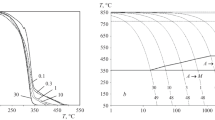Conclusions
-
1.
The very high residual compressive stresses that occur in the process of SPD lower the resistance to small plastic deformations during bending, and therefore the slight reduction of the residual stresses that occurs during postdeformation tempering leads to an increase of σprop and σT. This is evidently true for SPD samples with different structures (ferrite-pearlite, sorbite, bainite, martensite).
-
2.
For sorbitic steels the resistance to small plastic deformations, work of crack propagation, microdistortion, and macrostresses after SPD and tempering change less than for steels with a martensitic structure. Thus, for steels with a sorbitic structure the increase of the fatigue strength during postdeformation tempering is negligible.
-
3.
The increase in the fatigue strength of steels with a martensitic structure during tempering after SPD depends to a considerable extent on the changes in the substructure, especially the evenness and additional reduction of microdistortion (because of which the early manifestation of the microyield effect is prevented), and also the increase in the resistance to small plastic deformations due to the reduction of residual macrostresses.
Similar content being viewed by others
Literature cited
M. A. Balter et al., "Effect of tempering on the fatigue strength of steels with martensitic and bainitic structures after SPD," Fiz.-Khim. Mekh. Mater., No. 2 (1977).
I. V. Kudryavtsev, Internal Stresses as a Source of Strength [in Russian], Mashgiz, Moscow (1951).
L. A. Glikman, "Stability of residual stresses and their effect on the mechanical properties of metal and the strength of parts," in: Surface Quality and Service Life of Machine Parts [in Russian], LIÉI, Leningrad (1956).
M. Ya. Fuks et al., "Stability of residual stresses in the press-fit zone," Mashinovedenie, No. 3, 61 (1976).
M. A. Balter et al., "X-ray analysis of martensite with different carbon concentrations subjected to SPD," Fiz. Met. Metalloved.,31, No. 1, 114 (1972).
L. E. Alekseeva et al., "Lowering of resistance to small plastic deformations of steel quenched and tempered at low temperature as the result of loading in the elastic region," Fiz. Met. Metalloved.,37, No. 2, 397 (1974).
S. D. Gertsriken, N. N. Novikov, and V. S. Kopan', "Distribution of lattice defects along the diameter of the sample with different types of deformation," Ukr. Fiz. Zh.,4, No. 4, 530 (1959).
R. W. Kahn (editor), Physical Metallurgy [Russian translation], Vol. 1, Mir, Moscow (1967).
S. D. Gertsriken, N. N. Novikov, and V. S. Kopan', "The nature of thermo-emf resulting from deformation of metal," Ukr. Fiz. Zh.,4, No. 3, 293 (1959).
Additional information
Translated from Metallovedenie i Termicheskaya Obrabotka Metallov, No. 4, pp. 31–34, April, 1979.
Rights and permissions
About this article
Cite this article
Balter, M.A., Kurits, E.A. & Lyubchenko, A.P. Effect of tempering after roller burnishing on the physicomechanical properties of steel. Met Sci Heat Treat 21, 282–286 (1979). https://doi.org/10.1007/BF00775109
Issue Date:
DOI: https://doi.org/10.1007/BF00775109




